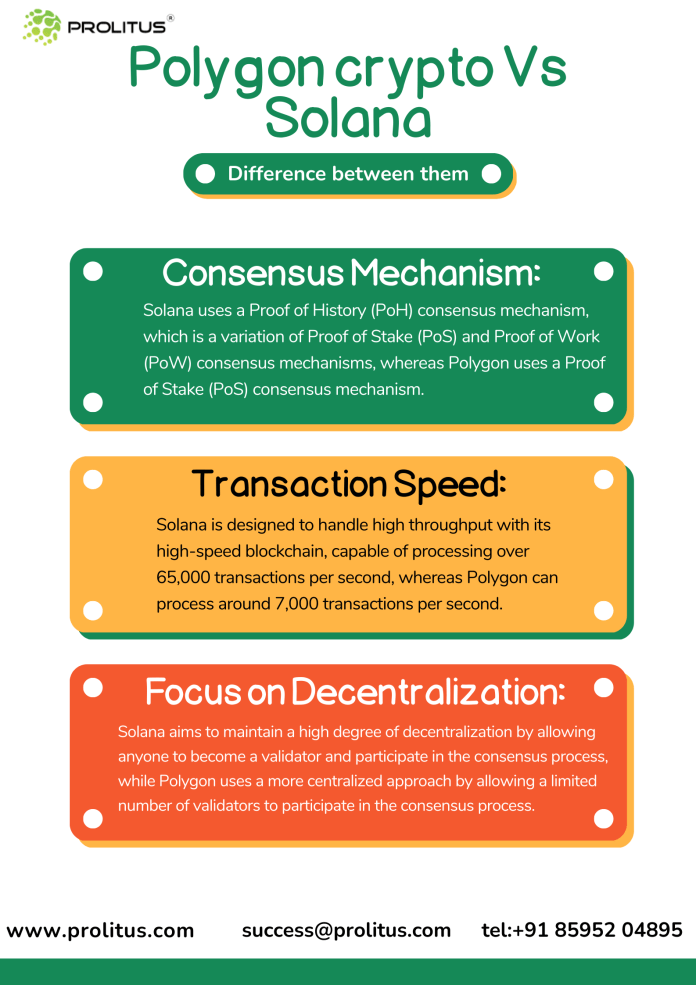Introduction:
Decentralized applications (dApps) have gained significant popularity in the crypto space over the past few years. With the increasing demand for blockchain-based solutions, developers are exploring new platforms to build their dApps on. Polygon and Solana are two such platforms that have gained popularity among developers due to their unique features and scalability solutions. In this article, we will compare Polygon vs Solana and try to determine which one is better suited for building decentralized applications.
Understanding Polygon:
Polygon, formerly known as Matic Network, is an Ethereum Layer-2 scaling solution that aims to provide faster and cheaper transactions for Ethereum users. Polygon is a sidechain solution that operates in parallel to the Ethereum network and is secured by a network of validators. Polygon uses a Proof of Stake (PoS) consensus mechanism and has an average block time of 2 seconds. Polygon’s architecture allows it to process up to 7,000 transactions per second, making it significantly faster than the Ethereum network.
Polygon has become popular among developers due to its low transaction fees and fast transaction times. Polygon also supports the deployment of smart contracts and has several toolkits and APIs that make it easy for developers to build and deploy their dApps on the platform. Some of the popular dApps built on Polygon include Aavegotchi, Decentraland, and QuickSwap.
Understanding Solana:
Solana is a high-performance blockchain platform that aims to provide fast, secure, and scalable transactions for dApps. Solana’s architecture is based on a unique consensus mechanism called Proof of History (PoH), which allows the network to process up to 65,000 transactions per second. Solana’s block time is also significantly faster than other blockchain networks, with an average block time of 400 milliseconds.
Solana has gained popularity among developers due to its high-speed transactions and low transaction fees. Solana also supports the deployment of smart contracts and has several toolkits and APIs that make it easy for developers to build and deploy their dApps on the platform. Some of the popular dApps built on Solana include Serum, Raydium, and Mango Markets.
Comparing Polygon vs Solana:
When it comes to comparing Polygon vs Solana, there are several key differences between the two platforms. One of the main differences is the consensus mechanism used by the two platforms. While Polygon uses a Proof of Stake (PoS) consensus mechanism, Solana uses a unique consensus mechanism called Proof of History (PoH). Both consensus mechanisms have their strengths and weaknesses, and the choice between the two will depend on the specific requirements of the dApp being built.
Another key difference between Polygon and Solana is their transaction speed. While Polygon can process up to 7,000 transactions per second, Solana can process up to 65,000 transactions per second. This makes Solana significantly faster than Polygon and better suited for high-frequency trading and other applications that require real-time transactions.
However, when it comes to transaction fees, Polygon has an edge over Solana. Polygon’s low transaction fees make it more affordable for developers to deploy their dApps on the platform. Solana, on the other hand, has higher transaction fees due to the high demand for transactions on the network.
Which one is the better choice for dApps?
When it comes to choosing between Polygon and Solana for building dApps, there is no one-size-fits-all solution. The choice will depend on the specific requirements of the dApp being built. For applications that require high-speed transactions and real-time data processing, Solana is the better choice. For applications that require low transaction fees and ease of deployment, Polygon is the better choice.
Conclusion:
In conclusion, both Polygon and Solana are excellent platforms for building decentralized applications. Both platforms offer unique features and scalability solutions that make
them attractive to developers. The choice between the two will depend on the specific requirements of the dApp being built. Developers should consider factors such as transaction speed, transaction fees, consensus mechanism, and ease of deployment when choosing between Polygon and Solana.
As the demand for blockchain-based solutions continues to grow, it is likely that more platforms will emerge to meet the needs of developers. It is essential for developers to stay up-to-date with the latest developments in the blockchain space and explore new platforms that offer unique features and scalability solutions.
In conclusion, both Polygon and Solana have a bright future in the blockchain space. With their unique features and scalability solutions, they are well-positioned to meet the needs of developers and users alike. Developers should carefully consider the specific requirements of their dApp when choosing between the two platforms and explore new platforms as they emerge in the future.
